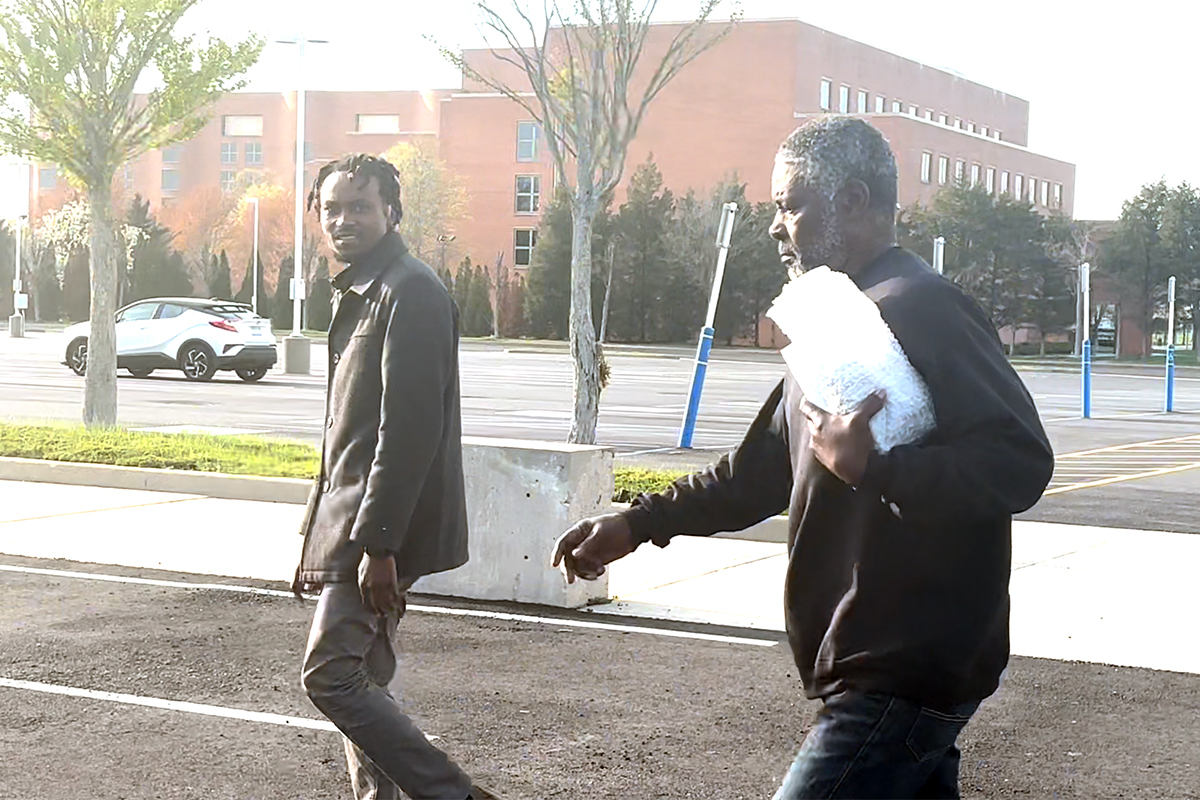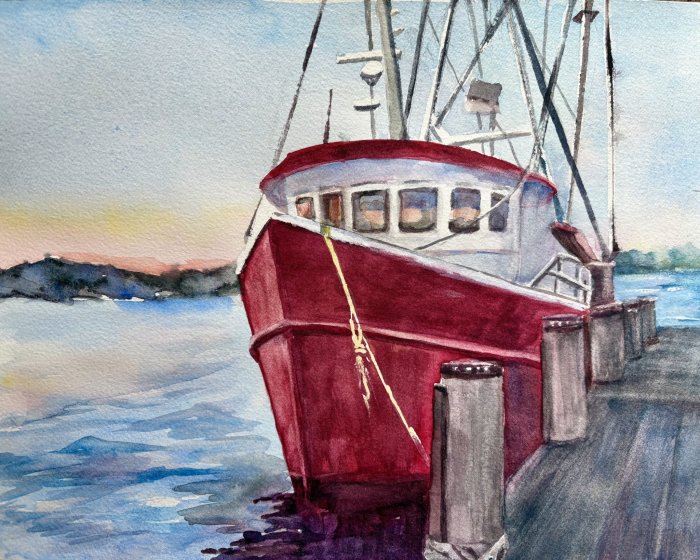Work is coming along on the oyster sloop Christeen, now berthed in Building J at the Western Waterfront, as she readies for the upcoming Spring season. The National Historic Landmark needed her keel replaced which necessitated taking apart the boat below the water line, putting in the new keel, hardware, and replacing antique square nails with screws and bolts – today’s more secure system of putting ships together.
Andrew Cooper, who works with shipwright Josh Herman was busy working on the oyster sloop when we visited J Building recently. He said part of the work included pulling out the old square nails and putting in screws and bolts.
That day he was working on “fairing” the frames of the ship – sanding them down an 1/8 of an inch or so to smooth them so that the planking contacts evenly with the framing.
He pointed to the caulking on the Christeen explaining that it comes in two forms, caulk, which is cotton caulking; and okum, the older form which is the material rope is made of, but not spun. He said after doing the fairing work, and adding the seam filler material, they will paint the boat and it will be ready for the water.
The work is stressful on your body, said Andrew. It means working curled up under the ship as they worked on the frames. “Your body parts all hurt after hanging out under there. But we are having a lot of fun,” he said.
There was a rack hung with dozens of clamps. “They are how we bolt everything together as we work,” he said.
The wood for the new mast came from a giant Douglas Fir from Washington where they turned the mast to the specifications provided by Shipwright Josh Herman. Josh said, “We finished the fabrication of the pieces, tapered it out and made the eight-sided tenon that is used to locate the mast in the keel, and created the hardware needed for the ship.”
He said the work on replacing the keel and restoring the boat to the water was expected to be finished by April 30. “That is not really enough time but we will get it done,” he said.
The work included taking off the standing rigging (what holds up the mast) and making replacements; splicing new wood into the gaff boom; taking all the old hardware off and having it galvanized as well as making their own wrought iron fastenings the way they did in the 19th century.
“We make everything custom, the metal work, the woodwork. The rigging for the sails was done by a fine maritime establishment I like to use,” said Josh.
Mr. Herman said they have about 12 volunteers who work on the Christeen. The volunteers work for a day or two a week. “Each volunteer is matched with a job, that is part of my job to do the matching. Once they learn what to do, they can come in when they want, to do the work,” he said.
That day, John Imhof of Bayville was working up on the deck of the Christeen. “I work four days a week,” he said.
Sitting outside Building J, in their front courtyard is the Christeen’s original keel, which had to be removed because of rot. Mr. Herman said: “It’s a piece of oak from 1883, it’s 40 feet long and weighs about 3,000 pounds. It should be kept indoors,” he added. The board will make the decision, he said.
Would the Ida May be his next project? “It might be the next,” said Mr. Herman.
Visiting Shipwright
Outside Building J, Frank Bladykas was coming along to visit and check up on the work. Mr. Bladykas built his own boat, the Tahiti, which he donated to The WaterFront Center. They recently sold it. Mr. Bladykas said, “It was a six-passenger boat and was Coast Guard rated. I sailed it for 30 years. The guy who bought it called up from the Hamptons and asked for a copy of the sail plan and I sent it to him. He said, ‘I’ll call you in the Spring for a sail.” Mr. Bladykas was sorry to lose the boat and was very proud of the way it sailed. “I never put a reef into it. When it was windy, I shorted the sail,” he said.
The Christeen, said Mr. Bladykas, is bigger than the Tahiti, and holds 25 people plus the captain and a crew member. It better fits the mission of the WFC in getting people out on the harbor.
Christeen History
The Christeen has taken thousands of people out on the Bay since the Spring of 2002, when she was given to the Waterfront Center (WFC) by the Christeen Oyster Sloop Preservation Corp.
The Christeen has been well maintained by the WFC’s able yard and dedicated group of volunteers, and she has held up very well under the pressure. However, during the winter of 2009, rot was found in her keel around the centerboard trunk.
Shipwright Josh Herman drained, patched and strengthened the area, and declared that the Christeen would hold together well for a few years. Nevertheless, her keel, which is the original from 1883, needed to be replaced.
The WFC Board scheduled this major repair to take place in Building J on the Western Waterfront beginning October 2010. “We are confident that with the guidance and expertise of our professional shipwright, the Christeen will return to service in April 2011, so that spring school programs will not be affected,” said Dave Waldo WFC executive director.
Mr. Waldo added, “The repairs have been taking place in ‘Building J’ just north of railroad tracks at the entrance of Theodore Roosevelt Memorial Park. Christeen’s repairs have taken place on public land managed by the NY State Department of Environmental Conservation and the Town of Oyster Bay. We could not provide public access nor undertake this project without the support of these government agencies. Please let our local officials and NYS Senator Carl Marcellino know how much you appreciate their support of our mission.”
































